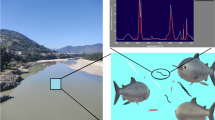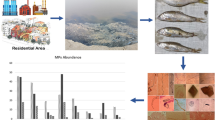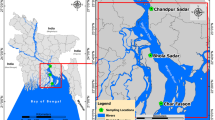Abstract
Contamination of aquatic systems mainly by urbanization and poor sanitation, deficient or lack of wastewater treatments, dumping of solid residues, and run off has led to the presence of particles, including manmade polymers, in tissues of many marine and freshwater species. In this study, the prevalence of microplastics (MPs) in freshwater fish from farmed and natural sources was investigated. Oreochromis niloticus from aquaculture farms in the Huila region in Colombia, and two local species (Prochilodus magdalenae and Pimelodus grosskopfii), naturally present in surface waters were sampled. Of the particles identified, fragments were the predominant type in the three tissue types (stomach, gill, and flesh) derived from farmed and natural fishes. MicroFT-IR spectroscopy was conducted on 208 randomly selected samples, with 22% of particles identified as MPs based on spectra with a match rate ≥ 70%. A total of 53% of identified particles corresponded to cellophane/cellulose, the most abundant particle found in all fish. Not all fish contained MPs: 44% of Oreochromis farmed fish contained MPs, while 75% of natural source fish contained MPs in any of its tissues. Overall, polyethylene terephthalate (PET), polyester (PES), and polyethylene (PE) were the prevalent MPs found in the freshwater fish. A broader variety of polymer types was observed in farmed fish. The edible flesh part of fish presented the lower prevalence of MPs compared to gill and stomach (gut), with gut displaying a higher frequency and diversity of MPs. This preliminary study suggests that the incidence and type of MPs varies in farmed verses natural fish sources as well as across different tissue types, with significantly less detected within the edible flesh tissues compared with stomach and gill tissues.




Similar content being viewed by others
Data availability
The data that support the findings of this study are available from the corresponding author upon reasonable request.
References
Akoueson F, Sheldon LM, Danopoulos E, Morris S, Hotten J, Chapman E, Li J, Rotchell JM (2020) A preliminary analysis of microplastics in edible versus non-edible tissues from seafood samples. Environ Pollut 263:14452. https://doi.org/10.1016/j.envpol.2020.114452
Andrade MC, Winemiller KO, Barbosa PS, Fortunati A, Chelazzi D, Cincinelli A, Giarrizzo T (2019) First account of plastic pollution impacting freshwater fishes in the Amazon: ingestion of plastic debris by piranhas and other serrasalmids with diverse feeding habits. Environ Pollut 244:766–773. https://doi.org/10.1016/j.envpol.2018.10.088
Bessa F, Barría P, Neto JM, Frias JPGL, Otero V, Sobral P, Marques JC (2018) Occurrence of microplastics in commercial fish from a natural estuarine environment. Mar Pollut Bull 128:575–584. https://doi.org/10.1016/j.marpolbul.2018.01.044
Biginagwa FJ, Mayoma BS, Shashoua Y, Syberg KS, Khan FR (2016) First evidence of microplastics in the African Great Lakes: recovery from Lake Victoria Nile perch and Nile tilapia. J Great Lakes Res 42(1):146–149. https://doi.org/10.1016/j.jglr.2015.10.012
Bordós G, Urbányi B, Micsinai A, Kriszt B, Palotai Z, Szabó I, Hantosi Z, Szoboszlay S (2019) Identification of microplastics in fish ponds and natural freshwater environments of the Carpathian basin, Europe. Chemosphere 216:110–116. https://doi.org/10.1016/j.chemosphere.2018.10.110
Campanale C, Massarelli C, Savino I, Locaputo V, Uricchio VF (2020) A detailed review study on potential effects of microplastics and additives of concern on human health. Int J Environ Res Public Health 17(4):1212. https://doi.org/10.3390/ijerph17041212
Collard F, Gasperi J, Gilbert B, Eppe G, Azimi S, Rocher V, Tassin B (2018) Anthropogenic particles in the stomach contents and liver of the freshwater fish Squalius cephalus. Sci Total Environ 643:1257–1264. https://doi.org/10.1016/j.scitotenv.2018.06.313
Courtene-Jones W, Quinn B, Ewins C, Gary SF, Narayanaswamy BE (2019) Consistent microplastic ingestion by deep-sea invertebrates over the last four decades (1976–2015), a study from the North East Atlantic. Environ Pollut 244:503–512. https://doi.org/10.1016/j.envpol.2018.10.090
de Sá LC, Oliveira M, Ribeiro F, Rocha TL, Futter MN (2018) Studies of the effects of microplastics on aquatic organisms: what do we know and where should we focus our efforts in the future? Sci Total Environ 645:1029–1039. https://doi.org/10.1016/j.scitotenv.2018.07.207
De Sales-Ribeiro C, Brito-Casillas Y, Fernandez A, Caballero MJ (2020) An end to the controversy over the microscopic detection and effects of pristine microplastics in fish organs. Sci Rep 10(1):1–19. https://doi.org/10.1038/s41598-020-69062-3
Departamento Administrativo Nacional de Estadística (2019). Boletín Técnico Exportaciones (EXPO) Diciembre 2018. https://www.dane.gov.co/files/investigaciones/boletines/exportaciones/bol_exp_dic18.pdf. Accessed 26 June 2019
Digka N, Tsangaris C, Torre M, Anastasopoulou A, Zeri C (2018) Microplastics in mussels and fish from the Northern Ionian Sea. Mar Pollut Bull 135:30–40. https://doi.org/10.1016/j.marpolbul.2018.06.063
Foley CJ, Feiner ZS, Malinich TD, Höök TO (2018) A meta-analysis of the effects of exposure to microplastics on fish and aquatic invertebrates. Sci Total Environ 631–632:550–559. https://doi.org/10.1016/j.scitotenv.2018.03.046
Free CM, Jensen OP, Mason SA, Eriksen M, Williamson NJ, Boldgiv B (2014) High-levels of microplastic pollution in a large, remote, mountain lake. Mar Pollut Bull 85(1):156–163. https://doi.org/10.1016/j.marpolbul.2014.06.001
Gómez HJ, Pasculli L, Bagés F (2014). Hacia La Sostenibilidad Y Competitividad De La Acuicultura Colombiana. https://wwwptpcomco/CMSPages/GetFileaspx?guid=37d850dd-342ª 4dce-b83c-4421f0bd9143 Accessed 19 July 2019
Halstead JE, Smith JA, Carter EA, Lay PA, Johnston EL (2018) Assessment tools for microplastics and natural fibres ingested by fish in an urbanised estuary. Environ Pollut 234:552–561. https://doi.org/10.1016/j.envpol.2017.11.085
Horton AA, Walton A, Spurgeon DJ, Lahive E, Svendsen C (2017) Microplastics in freshwater and terrestrial environments: evaluating the current understanding to identify the knowledge gaps and future research priorities. Sci Total Environ 586:127–141. https://doi.org/10.1016/j.scitotenv.2017.01.190
Horton AA, Jürgens MD, Lahive E, van Bodegom PM, Vijver MG (2018) The influence of exposure and physiology on microplastic ingestion by the freshwater fish Rutilus rutilus (roach) in the River Thames, UK. Environ Pollut 236:188–194. https://doi.org/10.1016/j.envpol.2018.01.044
Jabeen K, Su L, Li J, Yang D, Tong C, Mu J, Shi H (2017) Microplastics and mesoplastics in fish from coastal and fresh waters of China. Environ Pollut 221:141–149. https://doi.org/10.1016/j.envpol.2016.11.055
Karami A, Golieskardi A, Ho YB, Larat V, Salamatinia B (2017) Microplastics in eviscerated flesh and excised organs of dried fish. Sci Rep 7(1):1–9. https://doi.org/10.1038/s41598-017-05828-6
Lasso CA, Agudelo-Cordoba E, Jiménez-Segura L.F, Ramírez-Gil H et al (2011). I.Catálago de los recursos pesqueros continentales de Colombia. Serie Editorial Recursos Hidrobio- lógicos y Pesqueros Continentales de Colombia. Instituto de Investigación de Recursos Biológicos Alexander von Humboldt (IAvH). Bogotá
Li J, Qu X, Su L, Zhang W, Yang D, Kolandhasamy P, Li D, Shi H (2016) Microplastics in mussels along the coastal waters of China. Environ Pollut 214:177–184. https://doi.org/10.1016/j.envpol.2016.04.012
Li J, Green C, Reynolds A, Shi H, Rotchell JM (2018) Microplastics in mussels sampled from coastal waters and supermarkets in the United Kingdom. Environ Pollut 241:35–44. https://doi.org/10.1016/j.envpol.2018.05.038
Lusher AL, Hollman PCH, Mendoza-Hill JJ (2017). Microplastics in fisheries and aquaculture: status of knowledge on their occurrence and implications for aquatic organisms and food safety. In FAO fisheries and aquaculture technical paper (Vol. 614). 978-92-5-109882-0
McGoran AR, Clark F, Morritt D (2017) Presence of microplastic in the digestive tracts of European flounder, Platichthys flesus, and European smelt, Osmerus eperlanus, from the River Thames. Environ Pollut 220:744–751. https://doi.org/10.1016/j.envpol.2016.09.078
Nadal MA, Alomar C, Deudero S (2016) High levels of microplastic ingestion by the semipelagic fish Bogue Boops boops (L.) around the Balearic Islands. Environ Pollut 214:517–523. https://doi.org/10.1016/j.envpol.2016.04.054
Neves D, Sobral P, Ferreira JL, Pereira T (2015) Ingestion of microplastics by commercial fish off the Portuguese coast. Mar Pollut Bull 101(1):119–126. https://doi.org/10.1016/j.marpolbul.2015.11.008
Ory NC, Sobral P, Ferreira JL, Thiel M (2017) Amberstripe scad Decapterus muroadsi (Carangidae) fish ingest blue microplastics resembling their copepod prey along the coast of Rapa Nui (Easter Island) in the South Pacific subtropical gyre. Sci Total Environ 586:430–437. https://doi.org/10.1016/j.scitotenv.2017.01.175
Ory NC, Chagnon C, Felix F, Fernández C, Ferreira JL, Gallardo C, Garcés Ordóñez O, Henostroza A, Laaz E, Mizraji R, Mojica H, Murillo Haro V, Ossa Medina L, Preciado M, Sobral P, Urbina MA, Thiel M (2018) Low prevalence of microplastic contamination in planktivorous fish species from the Southeast Pacific Ocean. Mar Pollut Bull 127:211–216. https://doi.org/10.1016/j.marpolbul.2017.12.016
Pazos RS, Maiztegui T, Colautti DC, Paracampo AH, Gómez N (2017) Microplastics in gut contents of coastal freshwater fish from Río de la Plata estuary. Mar Pollut Bull 122:85–90. https://doi.org/10.1016/j.marpolbul.2017.06.007
Pozo K, Gomez V, Torres M, Vera L, Nuñez D, Oyarzún P, Mendoza G, Clarke B, Fossi MC, Baini M, Přibylová P, Klánová J (2019) Presence and characterization of microplastics in fish of commercial importance from the Biobío region in Central Chile. Mar Pollut Bull 140:315–319. https://doi.org/10.1016/j.marpolbul.2019.01.025
Roch S, Friedrich C, Brinker A (2020) Uptake routes of microplastics in fishes: practical and theoretical approaches to test existing theories. Sci Rep 10(1):3896. https://doi.org/10.1038/s41598-020-60630-1
Rochman CM, Tahir A, Williams SL, Baxa DV, Lam R, Miller JT, Teh FC, Werorilangi S, Teh SJ (2015) Anthropogenic debris in seafood: plastic debris and fibers from textiles in fish and bivalves sold for human consumption. Sci Rep 5:1–10. https://doi.org/10.1038/srep14340
Sánchez-Triana E, Ahmed K et al (2007). Environmental priorities and poverty reduction : a country environmental analysis for Colombia. Directions in Development. Environment and Sustainable Development. http://hollis.harvard.edu/?itemid=%7Clibrary/m/aleph%7C010684189. Accessed 4 Agust 2019
Santana MFM, Moreira FT, Turra A (2017) Trophic transference of microplastics under a low exposure scenario: insights on the likelihood of particle cascading along marine food-webs. Mar Pollut Bull 121(1–2):154–159. https://doi.org/10.1016/j.marpolbul.2017.05.061
Schwarz AE, Ligthart TN, Boukris E, van Harmelen T (2019) Sources, transport, and accumulation of different types of plastic litter in aquatic environments: a review study. Mar Pollut Bull 143:92–100. https://doi.org/10.1016/j.marpolbul.2019.04.029
Silva-Cavalcanti JS, Silva JDB, de França EJ, de Araújo MCB, Gusmão F (2017) Microplastics ingestion by a common tropical freshwater fishing resource. Environ Pollut 221:218–226. https://doi.org/10.1016/j.envpol.2016.11.068
Slootmaekers B, Catarci CC, Belpaire C, Saverwyns S, Fremout W, Blust R, Bervoets L (2019) Microplastic contamination in gudgeons (Gobio gobio) from Flemish rivers (Belgium). Environ Pollut 244:675–684. https://doi.org/10.1016/j.envpol.2018.09.136
Su L, Xue Y, Li L, Yang D, Kolandhasamy P, Li D, Shi H (2016) Microplastics in Taihu Lake, China. Environ Pollut 216:711–719. https://doi.org/10.1016/j.envpol.2016.06.036
Van Cauwenberghe L, Janssen CR (2014) Microplastics in bivalves cultured for human consumption. Environ Pollut 193:65–70. https://doi.org/10.1016/j.envpol.2014.06.010
Acknowledgments
Thanks to Emma Chapman and the private aquaculture sector of the region of Huila, Colombia. This work was funded by a Global Challenges Research Fund grant to the University of Hull.
Funding
The resources used for this research were provided by the University of Hull from the grant funded by the Higher Education Funding Council for England, which includes an allocation from the Global Challenges Research Fund (GCRF). An agreement was established between the University of Hull, the Surcolombia University and a seafood processing facility from the region of study, with the aim to develop a research named “Microplastic contamination of the global food supply: obtain of initial data for baseline creation evidencing the status of fish farmed in the Huila region, Colombia”, which was the base for this manuscript.
The authors of the manuscript were autonomous for the design of the study, as for the collection, analysis, interpretation of data and the writing of the manuscript, neither the funding body nor the organizations participating in the agreement influenced the independency of the authors.
Author information
Authors and Affiliations
Contributions
AG contributed with the experimental design of the study, with the collection, processing, and analysis of fish samples in the laboratory, with the analysis and interpretation of data, and with the writing of the manuscript. DS contributed with the experimental design of the study, with the sampling of fish samples, with the interpretation of data, and with writing of the manuscript. JL contributed with the chemical determination of microplastics in the laboratory, and with the analysis of data. JR contributed with the experimental design of the study, with the training and technological transfer of knowledge, and with the revision of the manuscript. All authors read and approved the final manuscript.
Corresponding author
Ethics declarations
Ethics approval and consent to participate
The Surcolombiana University, being a public entity in Colombia, is governed by the guidelines given by Colciencias in the document POLITICS OF ETHICS, BIOETHICS AND SCIENTIFIC INTEGRITY, which describes the minimum guidelines that lead all the actors of the National System of Science, Technology and Innovation (SNCTel). In this manner, in order to ensure the appropriate ethical review of research grants, the Vice-rectory of Research and Social projection of the Surcolombiana University, periodically monitor the normal development of investigations. For this purpose, the research that framed this manuscript was approved for the committee of investigations (COCEIN) according to the minutes 02 of February 14 of 2018. In addition, the authors declare that all biological specimens were provided by local farmers and fishers.
Consent for publication
Not applicable.
Competing interests
The authors declare that they have no competing interests.
Employment
Not applicable
Additional information
Responsible Editor: Philippe Garrigues
Publisher’s note
Springer Nature remains neutral with regard to jurisdictional claims in published maps and institutional affiliations.
Rights and permissions
About this article
Cite this article
Garcia, A.G., Suárez, D.C., Li, J. et al. A comparison of microplastic contamination in freshwater fish from natural and farmed sources. Environ Sci Pollut Res 28, 14488–14497 (2021). https://doi.org/10.1007/s11356-020-11605-2
Received:
Accepted:
Published:
Issue Date:
DOI: https://doi.org/10.1007/s11356-020-11605-2




